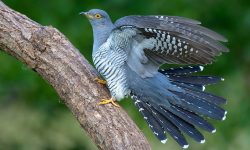Grebes are elegant, fish-eating diving birds known for their expert swimming and fascinating behaviors. In Michigan, with its abundance of lakes, marshes, and shoreline habitats, six distinct grebe species have been recorded. Some are common residents, while others are rare or seasonal visitors. This guide explores each of these species, focusing on where and when to find them, what they look like, and how they behave.
1. Pied-billed Grebe (Podilymbus podiceps)
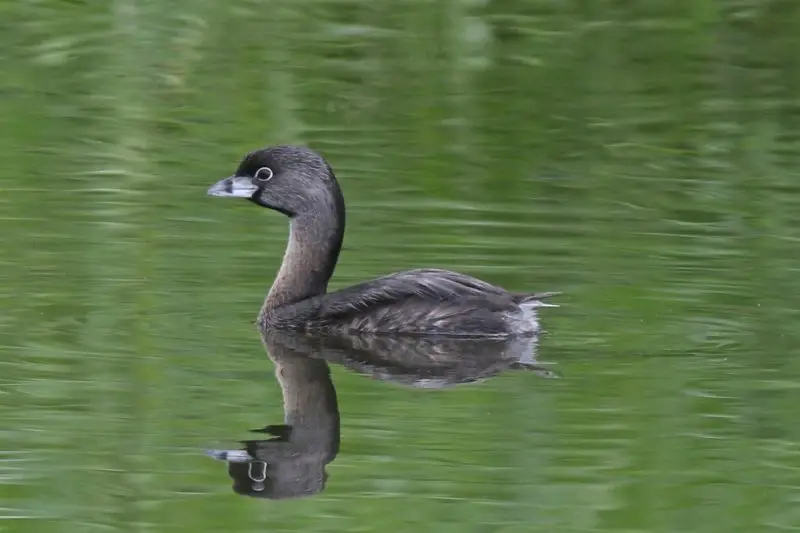
Appearance and Identification
The Pied-billed Grebe may be small and unassuming at first glance, but it is a master of camouflage and aquatic stealth. Measuring about 12 to 15 inches in length, it sports a compact, chunky body cloaked in warm brown feathers, often with a slightly darker crown and pale underparts. The most distinctive feature is its thick, ivory-colored bill marked with a bold black band—a field mark most prominent during the breeding season and the source of its name.
Unlike the more flamboyant grebes with crests or tufts, the Pied-billed Grebe has a plain, crestless head, giving it a humble appearance. But what it lacks in ornamentation, it makes up for with functional elegance. Its dense plumage is highly water-resistant, and its subtle coloration blends seamlessly into reedy wetland backgrounds.
Habitat and Behavior
The Pied-billed Grebe is one of the most widespread and familiar grebes in Michigan. It thrives in freshwater marshes, vegetated ponds, slow-moving rivers, and shallow lakes, especially those rich in aquatic plants where it can hunt and hide. In the southern part of the state, it can be found year-round, while northern populations are mostly migratory.
This species is a solitary and secretive diver, often seen alone or in loose pairs. It uses its lobed toes to paddle quietly through the water, and when threatened, it prefers to sink rather than fly, vanishing beneath the surface with barely a ripple. Its vocalizations include a series of gulping, cuckoo-like hoots, especially during the breeding season, when pairs defend territories and build floating nests hidden among cattails and reeds.
Adapted to a life between the surface and the depths, the Pied-billed Grebe is a quiet but ever-present sentinel in Michigan’s wetlands—a bird more often heard than seen, and always worth a second look.
2. Horned Grebe (Podiceps auritus)
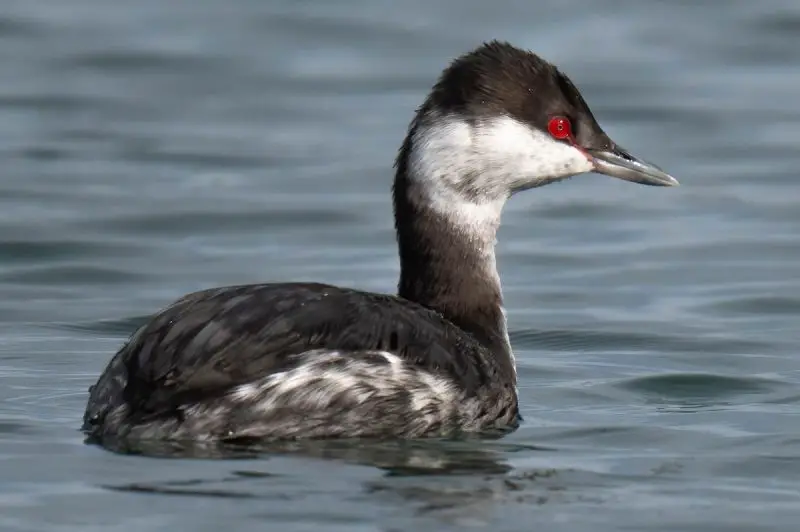
Appearance and Identification
The Horned Grebe is one of the most visually captivating grebes, especially during the breeding season. It dons a jet-black crown, blazing red eyes, and its most distinctive feature—bright golden feather plumes that fan out from each eye like fiery horns. Its neck and flanks turn a rich chestnut-red, creating a striking contrast against its dark upperparts. This dramatic transformation makes it a favorite among bird photographers and enthusiasts alike.
In winter, the Horned Grebe adopts a far more subdued look, trading its flamboyant hues for clean whites and soft grays. Even in this quieter phase, its compact build, thin straight bill, and characteristic posture—low in the water with a slightly uptilted head—make it readily identifiable with some practice.
Habitat and Behavior
Though it doesn’t breed in Michigan, the Horned Grebe is a reliable spring and fall migrant, appearing on both inland lakes and expansive waters like Lake Michigan and Lake Huron. During migration, they often gather in small numbers, floating singly or in loose groups as they rest and refuel.
Horned Grebes are excellent divers, hunting small fish and aquatic invertebrates beneath the surface. Unlike the more reclusive Pied-billed Grebe, they are somewhat more approachable and visible, especially during early mornings when the water is calm. However, they are still quick to dive when disturbed, disappearing with a smooth plunge and reappearing yards away.
Their stopover in Michigan is relatively brief, but for those few weeks each year, these golden-horned travelers bring a flash of exotic flair to the state’s waters—a fleeting spectacle worth seeking out.
3. Red-necked Grebe (Podiceps grisegena)
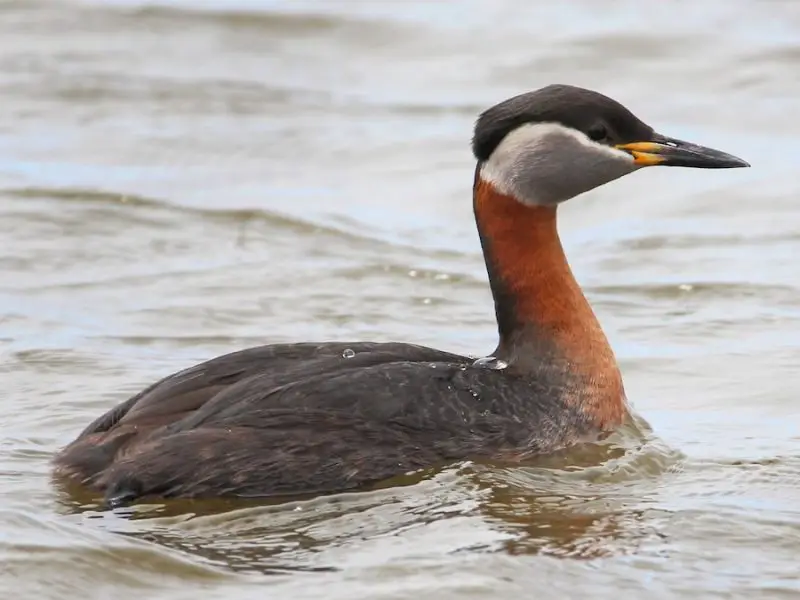
Appearance and Identification
The Red-necked Grebe is a bold and commanding presence on the water, larger and more robust than its Horned Grebe cousin. In breeding plumage, it lives up to its name with a deep chestnut-red neck, a dramatic contrast to its dark cap and pale cheeks. Its dagger-like bill is long and powerful, with a striking yellow base that glows in the spring light.
Outside of the breeding season, the Red-necked Grebe undergoes a transformation into more subdued shades of gray and white. The head turns a soft silver, the back darkens, and the neck loses its red hue, but the bird retains its distinctive profile—a thick neck, large body, and pointed bill that sets it apart even from a distance.
Habitat and Behavior
Though not a breeder in Michigan, the Red-necked Grebe is a regular migrant, particularly visible during spring and fall. It favors large, open bodies of water such as Lake Michigan, Lake Huron, and expansive inland lakes, where it can rest and feed undisturbed.
These grebes are strong, purposeful divers, propelling themselves underwater in search of fish, crustaceans, and aquatic insects. Their movements are smooth but powerful, and they often surface far from where they dove, making them elusive to track.
During migration stopovers, they tend to stay offshore, loafing in small rafts or foraging solo in deeper waters. Their presence is fleeting but memorable, offering birders a glimpse of one of the grebe family’s most rugged and far-traveling members.
With their commanding size and rich breeding colors, Red-necked Grebes add drama and depth to Michigan’s spring and autumn waterbird spectacles—a migratory marvel passing through on silent wings and steady strokes.
4. Eared Grebe (Podiceps nigricollis)
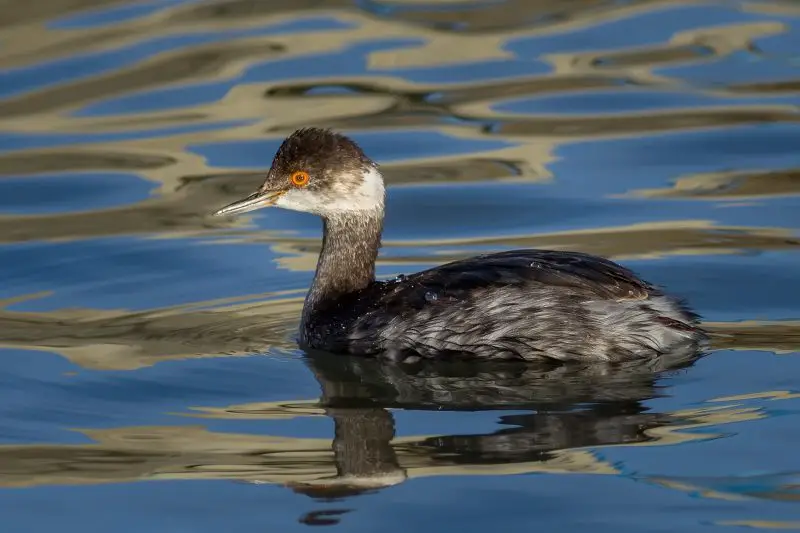
Appearance and Identification
The Eared Grebe is one of the most spectacularly adorned members of the grebe family. During the breeding season, it is unmistakable: its head turns jet black, its eyes glow a vivid scarlet, and a fan of bright golden feathers arcs outward from behind each eye, giving the bird an otherworldly appearance. Its body takes on deep tones of black and chestnut, and its slender bill curves ever so slightly upward, adding a refined touch to its already striking profile.
In winter, this flamboyant look fades dramatically. The Eared Grebe dons a modest cloak of pale gray and white, losing its feathered “ears” and adopting a sleeker silhouette. Yet even in this phase, its small size, upward-tilted bill, and distinctive posture make it recognizable to the seasoned observer.
Habitat and Behavior
Though the Eared Grebe does not breed in Michigan, it is an uncommon but regular migrant, especially in late spring and early fall. It favors quiet inland lakes, shallow wetlands, and secluded marshes where it can feed and rest during its journey between breeding and wintering grounds.
This species is known for being one of the most aquatically specialized grebes in the world. It feeds almost entirely underwater, pursuing insects, larvae, and tiny crustaceans with graceful dives. Its legs are placed far back on its body, giving it incredible propulsion beneath the surface but rendering it nearly helpless on land.
Eared Grebes often migrate in tight flocks, and their movements can be erratic—some years bringing more individuals to Michigan than others. Birders prize their sightings both for the bird’s rarity and for its exquisite breeding plumage. Spotting one in full display is like catching a glimpse of a jewel skimming across the water—a fleeting, golden moment for those lucky enough to witness it.
5. Western Grebe (Aechmophorus occidentalis)

Appearance and Identification
The Western Grebe is the epitome of elegance and athleticism among North American waterbirds. With its elongated neck, dagger-like yellow bill, and sleek black-and-white plumage, it commands attention as it glides gracefully across open water. A sharp contrast between the jet-black crown and nape and the crisp white of its throat and underparts makes this grebe instantly recognizable.
Its brilliant red eyes add a touch of drama, particularly when seen up close. One of the key field marks that separates the Western Grebe from the similar Clark’s Grebe is the placement of the black plumage around the eye: in the Western, the black extends below the eye, giving it a shadowed, masked appearance.
Habitat and Behavior
Though it breeds primarily in western North America, the Western Grebe is an occasional but celebrated visitor to Michigan, usually during fall or spring migration. Sightings are rare but often occur on the Great Lakes, where birders sometimes catch glimpses of these striking grebes amid rafts of other waterbirds.
Western Grebes are known for their dramatic courtship rituals, which include the famous “rushing” display—two birds running side-by-side across the water’s surface in perfect synchronization. While such displays are typically seen on their breeding lakes in the west, their fluid swimming style and long, graceful dives can still be admired during their brief appearances in Michigan.
Because they tend to stay far from shore and blend easily into open water scenes, locating a Western Grebe often requires scoping distant flocks or scanning calm waters during peak migration windows. When found, their striking profile and serene movements make them an unforgettable highlight for any birder fortunate enough to spot one in the Great Lakes region.
6. Clark’s Grebe (Aechmophorus clarkii)
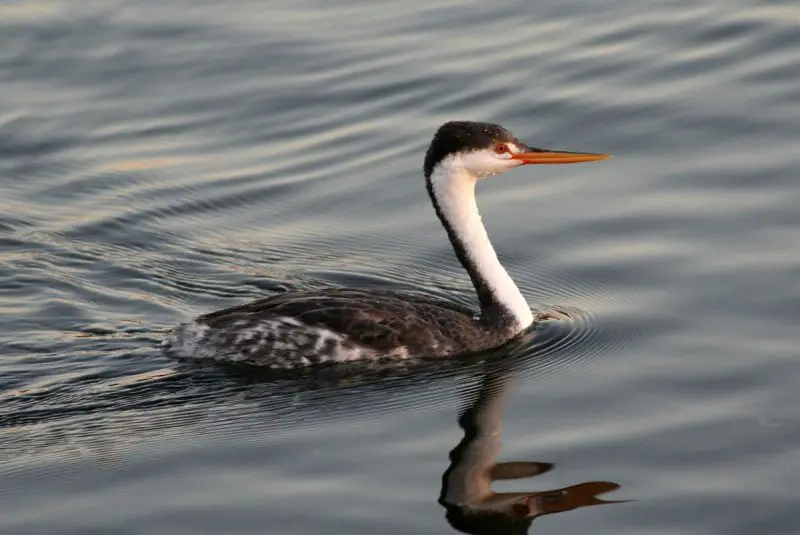
Appearance and Identification
Clark’s Grebe is a sleek and graceful waterbird that closely resembles the Western Grebe in both size and build, yet offers key visual cues for the discerning observer. It sports the same slender frame and elongated neck but differs with its brilliant orange bill and strikingly white face—a feature that encircles the eyes rather than being shaded by dark feathers. This pale facial pattern gives it a more open, clean expression compared to the Western Grebe’s masked look.
When seen side-by-side with its cousin, the differences become more pronounced: Clark’s Grebe shows more white around the eye, and its bill appears more vividly orange, especially under sunlight. The rest of its plumage mirrors the bold black-and-white contrast seen in Western Grebes, maintaining a sharp and elegant profile.
Habitat and Behavior
In Michigan, the Clark’s Grebe is a true avian rarity—an extremely uncommon vagrant recorded only on rare occasions. Most sightings come from large open water bodies, such as the Great Lakes, where it sometimes appears among flocks of Western Grebes during migration. Because of their similar appearance, identifying a Clark’s Grebe in the field is a fun but challenging exercise, often requiring patience, good optics, and keen attention to subtle features.
Clark’s Grebes are known for participating in the same spectacular courtship displays as their relatives, including synchronized “rushing” dances across the surface of breeding lakes in the western U.S. Though Michigan lies outside their typical range, every sighting offers a thrilling opportunity to observe this elegant bird far from its usual haunts—a feathered enigma that reminds birders just how unpredictable nature can be.
Conclusion
Michigan’s wetlands and lakes offer essential stopover and breeding habitats for a diverse array of grebes. From the ever-present Pied-billed Grebe to the elusive Clark’s Grebe, each species brings a unique shape, call, and behavior to the landscape. For birders and wildlife enthusiasts, knowing when and where to find these six grebes enhances the experience of exploring Michigan’s rich aquatic ecosystems.






